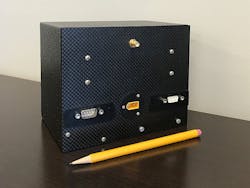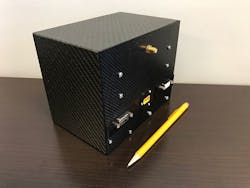VStar Systems adds remote operations capability to MA-C SIGINT sensor for UAS payloads
SAN DIEGO. Engineers at VStar Systems, a privately held aerospace and defense systems company in San Deigo, Calif., have enhanced the company’s MA-C signals intelligence (SIGINT) sensor for remote operation, foregoing the need for operators to be co-located with the unmanned aircraft system (UAS) ground station.
A key capability is the ability to operate the sensor over the existing Internet or even cellular network, without needing a dedicated link to the aircraft. VStar Systems is now running this mode routinely with the sensor physically located in Northern California, while the ground station is in Southern California and the cellular network connects the two.
The low-bandwidth requirement enables future satellite communications (SATCOM) capabilities over even the smallest data links, officials say. The sensor weighs two pounds and consumes 25 watts, enabling even very small drones to be configured to provide beyond line of sight (BLOS) operations and send real-time intelligence to operators.
“With most sensors on smaller unmanned aerial vehicles (UAVs), the UAV sensor operator and aircraft operator are usually one and the same or are near each other,” says Andy von Stauffenberg, CEO of VStar Systems. “We took that need completely away and now the aircraft can be operated separately from the SIGINT operator.”
This added capability brings three main benefits:
1. Operator stations can be consolidated for a wide variety of UAVs, UGVs (unmanned ground vehicles) and USVs (unmanned surface vehicles) to provide the maximum benefit. This allows for a single ground station to use multiple sensors on multiple aircraft or ground platforms—
providing consistent coverage. If one has to return home due to low fuel or battery concerns, another can simply take over and the sensor operators would continue the mission.
2. It allows for smaller crews to go into remote (and often dangerous) locations—keeping the key decision makers in the back with the primary assets while a single plane operator can be near the hotspot. This also allows for rapid deployments, since only a subset of the entire system needs to go out, and allows the key decision makers to get up to date, real time information in a fraction of the time.
3. It increases the range of the aircraft. Most of the time, the aircraft endurance is mismatched with the datalink range. An aircraft might be able to fly for 8-10 hours at a time, but with LOS datalinks they sometimes only get 40 miles maximum range. That means it will take off, go out about 30 miles and then fly circles for six hours before coming back. The remote operations capability and low datalink requirements allow UAVs to use long range datalinks or even small SATCOM systems to significantly extend the range, something not possible with visual EO/IR or radar systems.
“Remote operations capabilities adds significant operational utility to the overall system – but we are far from done,” von Stauffenberg adds. “Our current plans and ideas will take us out at least another year or two until we are satisfied with their development and integration and we will likely think of new capabilities along the way.”
Founded by entrepreneur and U.S. Navy veteran Von Stauffenberg, VStar Systems designed its MA-C Sensor System to provide signal intelligence such as signal copy, signal identification and direction finding to a wide variety of platforms. The MA-C system is designed to function as a highly modular, scalable, flexible tactical COMINT sensor, specifically intended to address design challenges posed by Class 2 or 3 UAVs, while also optimizing operator efficiency. At a weight of as low as 2 lbs., MA-C provides COMINT capabilities to UAV's which previously were limited to optical payloads due to the large size and weight of other SIGINT sensors on the market. The MA-C Sensor system is one of several products under the MA-X Modular Airborne Signal Intelligence System, a scalable solution designed to provide critical intelligence at a more affordable price point and greater flexibility than comparable systems.
VStar Systems Inc. is an aerospace and defense company that specializes in rethinking the way systems were traditionally designed to subsequently provide creative and effective solutions to new and emerging problems. By focusing on the full circle integration of components including hardware, software, as well as the technology, processes and human aspects, VStar Systems is able to provide real-time and applicable solutions to advanced issues at hand.
VStar specializes in:
· ISR Sensor Systems
· Quick Reaction Capabilities/Rapid Technology Insertion
· Airborne and Ground Data Processing
· Processing, Exploitation and Dissemination
Search the Aerospace & Defense Buyer's Guide
The go-to resource for Intelligent Aerospace technology news & information:
Covering key topics
Across all market segments
Subscribe to the free Intelligent Inbox e-newsletter
Subscribe to receive all the latest aerospace technology news & information, delivered directly to your e-mail inbox twice a week (Tuesdays and Thursdays). Sign upfor your free subscription to the Intelligent Inbox e-newsletter at http://www.intelligent-aerospace.com/subscribe.html.
Connect on social media
Keep pace with aerospace innovation and opportunities via your favorite social media channels. Connect with Intelligent Aerospace on Twitter (@IntelligentAero), LinkedIn,Google+, and Instagram.





